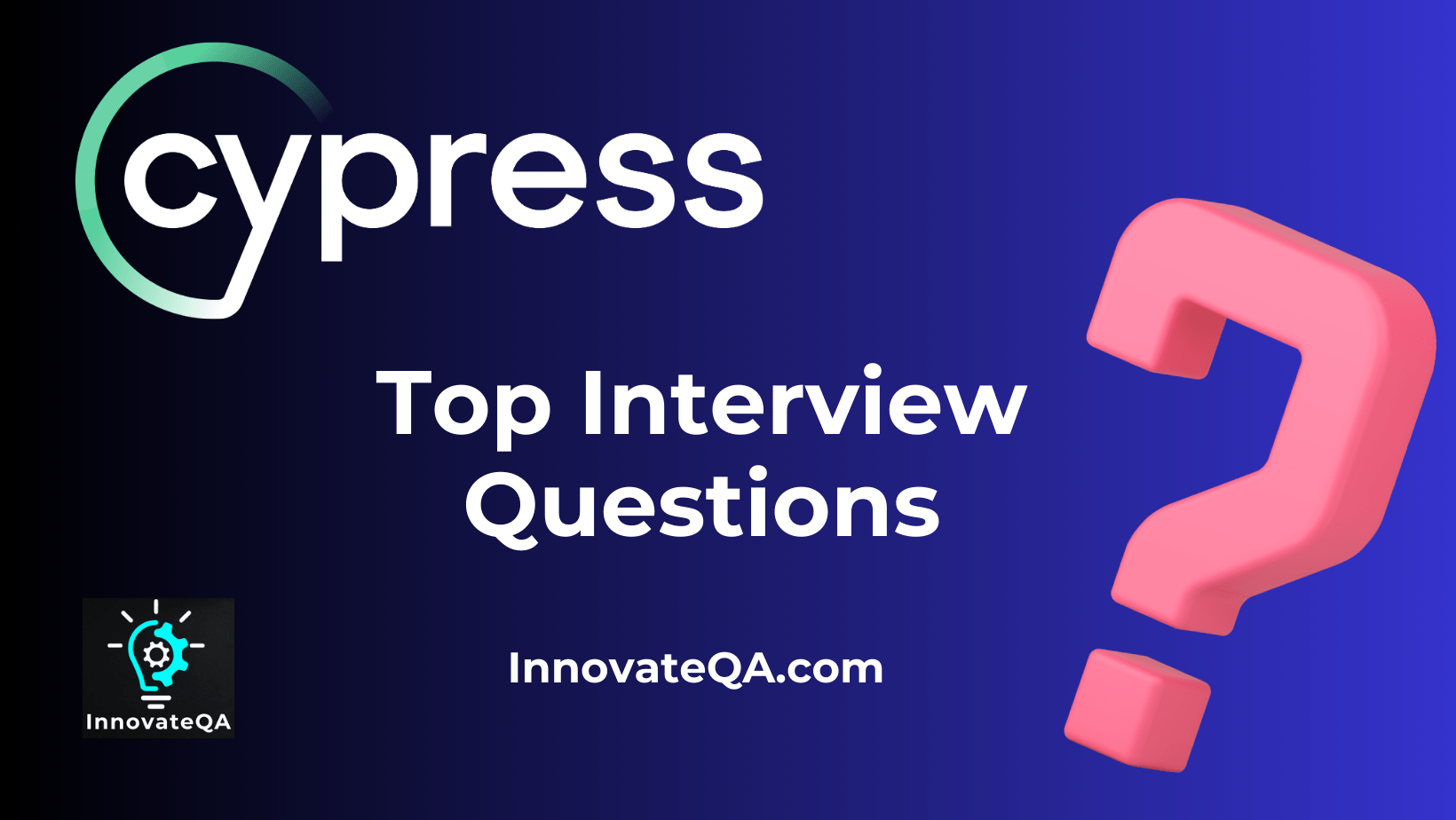Table of Contents
ToggleIntroduction
In the constantly evolving field of software development, staying on top of the latest tools and technologies is often necessary to advance in your profession. Cypress is a robust end-to-end testing framework that has become very popular due to its ease of use and efficiency. It’s crucial to have an in-depth understanding of Cypress, whether of whether you’re an experienced automation tester or a job seeker getting ready for an interview. We’ll explore the most common Cypress interview questions in this article so you may approach any interview situation with confidence.
What is Cypress?
Cypress is an end-to-end testing framework that is open-source and intended to make web application testing easier. Cypress is an end-to-end testing tool that lets automation testers/developers simulate and automate user interactions in a web application to make sure everything works as it intended. End-to-end testing’s main objective is to make sure that all of an application’s parts from the user interface (UI) to the backend procedures function smoothly together.
How does Cypress differ from other testing tools?
Cypress is an unique framework for end-to-end testing because of its many special features and clear benefits. Understanding what makes Cypress unique can help you appreciate this tool more in interviews and in real-world situations. The following are the key features and benefits that set Cypress apart:
- Real-Time Reloads: Cypress’s ability to deliver real-time reloads while you develop and edit your tests is one of its best features. With the help of the live reloading feature, automation testers may see the effects of changes immediately, greatly accelerating the automation and debugging process.
- Automatic Waiting: Cypress increases test reliability by intelligently waiting for items to appear and operations to finish without requiring explicit commands. Test scripts become more reliable and robust as a result of this feature, which also removes the headache of handling timeouts.
- Time-Travel Debugging: Cypress’s time-travel debugging capability lets developers see the current state of the application at any time while a test is running. This visual debugging feature makes debugging easier overall by helping to precisely identify and resolve issues.
- Built-in Test Runner: Cypress includes a built-in interactive test runner that shows test execution in real time. Debugging is made easier for developers by being able to visually watch test progress and observe the condition of the application.
- Simplified Installation: Cypress is easy to install and operate with simple commands, allowing test automation testers/developers to quickly set up and begin testing. The simple installation helps ensure that new users have a smooth onboarding experience.
- Cross-Browser Testing: Although Cypress was first made for Chrome, it now supports a number of other browsers, including Microsoft Edge, Firefox and Electron. Because of its cross-browser compatibility, tests may be run on a variety of browsers, meeting the requirement for extensive browser coverage.
- Network Traffic Control: Cypress gives automation testers/developers the ability to handle and monitor on network requests, which makes it easier to test APIs thoroughly and ensure proper connectivity with other services. Cypress’s ability to handle end-to-end testing scenarios including external data sources is improved by this feature.
Explain the Architecture of Cypress
- The majority of Test Automation Tools, such as Selenium, function by launching outside of the browser and sending commands over the network.
- Cypress is a complete reverse. Cypress runs in sync with your application within the same run loop.
- Cypress is powered by a Node server process. Cypress and the Node process exchange messages, coordinate, and carry out tasks for one another continuously.
- It can react to events in your application in real time and work outside of the browser for tasks requiring a higher privilege because it have access to both the frontend and the backend.
- Cypress also reads and modifies web traffic dynamically at the network layer.
How does Cypress handle asynchronous operations?
Cypress automatically pauses between commands and assertions to ensure they finish before proceeding. It does not require explicit waits in the test code; instead, it waits intelligently for elements to appear or operations to finish.
What is the purpose of fixtures in Cypress?
Static data can be loaded into tests and stubbed using Cypress fixtures. They enable you to test the behavior of the program in a variety of scenarios and conditions.
What is the headless mode for Cypress tests?
Cypress may be used with the command line interface to run headless. For testing in a continuous integration/continuous delivery (CI/CD) environment, you can use the –headless flag to run tests without the Test Runner.
In Cypress, what are custom commands and how do you use them?
By building reusable commands, you can expand Cypress’s capability with custom commands. Custom commands can be defined in the commands.js file and are accessible globally in your tests.
Explain the concept of Cypress hooks.
Functions known as Cypress hooks execute at various points during the test lifecycle. before, beforeEach, after, and afterEach are among them. With hooks, you can change the test context or carry out setup and teardown operations.
What is the role of the cy.wait() command in Cypress, and when should it be used?
The cy.wait() command is used to pause the test execution. While it can be helpful in debugging or specific scenarios, it should be used judiciously to avoid introducing unnecessary delays in test execution.
How does Cypress handle browser events, such as handling mouse clicks or keyboard input?
Cypress provides commands like cy.click(), cy.type(), and others to simulate user interactions such as mouse clicks and keyboard input. These commands allow you to programmatically interact with the application as a user would.
Discuss the role of the Cypress Dashboard in a testing setup.
The Cypress Dashboard is a service provided by Cypress that offers features like test recording, parallelization, and insights into test runs. It can be used to monitor and manage test executions, especially in a CI/CD environment.
Explain the concept of assertions in Cypress. How do assertions differ from regular JavaScript assertions?
Assertions in Cypress are used to validate that the application behaves as expected. Cypress provides a set of built-in assertions like should and expect. Unlike regular JavaScript assertions, Cypress assertions are automatically retried to account for asynchronous behavior, providing more robust testing.
How can you configure and use environment variables in Cypress?
Cypress supports environment variables for configuration. You can set environment variables in your scripts and load them from a .env file. This is useful for handling sensitive information or configuring different environments.
Discuss the significance of retries in Cypress tests. When and how should you use them?
Cypress automatically retries commands and assertions to handle asynchronous behavior and flaky tests. While retries are beneficial, it’s crucial to understand when and how to use them effectively. Adjusting the retry settings or using explicit retries with cy.retry() can be employed based on the specific testing scenario.
What is the role of the Cypress Test Runner in the testing process?
The Cypress Test Runner is a graphical interface that facilitates the execution and debugging of Cypress tests. It provides real-time feedback, allows you to see the application alongside the test, and aids in identifying issues during test execution.
Explain the difference between cy.visit() and cy.request() in Cypress.
cy.visit() is used to navigate to a URL and interact with the application through the UI, while cy.request() is used to make HTTP requests directly without interacting with the UI. Understanding when to use each is crucial for effective testing.
How can you handle file uploads in Cypress tests?
Cypress allows file uploads using the cy.fixture() command to read the contents of a file and cy.get().attachFile() to attach the file to an input element. This enables testing scenarios involving file uploads in web applications.
What is the purpose of the cy.clearCookies() command in Cypress?
The cy.clearCookies() command is used to clear all cookies from the browser. It’s helpful when you need to start a test with a clean slate, ensuring that previous state or authentication information doesn’t affect the current test.
You May Also Like:
🔝4️⃣5️⃣➕ Manual Testing Scenario Based Interview Questions 2024 🚀
🤖 🔝6️⃣5️⃣ ➕Automation Testing Interview Questions 2024 🚀
🔝6️⃣5️⃣➕ API Testing Interview Questions 2024 🚀
🔝6️⃣5️⃣➕ Postman Interview Questions 2024 🚀
🔝3️⃣0️⃣➕ Cucumber Interview Questions 2024 🚀
🔝5️⃣0️⃣➕ TestNG Interview Questions 2024 🚀
🤖🔝💯+Selenium Interview Questions For Experienced 2024 🚀
🍵Top 💯+ Java Interview Questions For Automation Testing 2024 🚀
🔝6️⃣5️⃣➕ JMeter Interview Questions 2024 🚀

